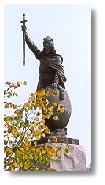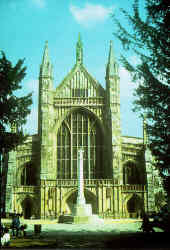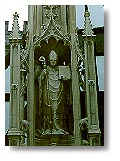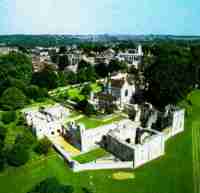WINCHESTER
The City of Winchester in Hampshire is closely connected
with the history of the monarchy. It was the capital of the Anglo-Saxon
kingdom of Wessex, and from the time of  Alfred
the Great in the 9th century, the principal home of the Anglo-Saxon rulers.
The present royal family traces its ancestry back to Egbert, Alfred's grandfather
and the first Anglo-Saxon "bretwalda" or ruler to call himself King of
England. Alfred helped the Anglo-Saxons rebuff the attacks of the
Danes by reforming the army or fyrd, creating a new class of nobles or
Thegns, and eventually confining the Danes to a territory in the east known
as the Danelaw. In order to rule more efficiently, he divided the
country into shires, adopted a single law code (the Dooms of Alfred), and
promoted scholarship, both in Latin and the vernacular.
Alfred
the Great in the 9th century, the principal home of the Anglo-Saxon rulers.
The present royal family traces its ancestry back to Egbert, Alfred's grandfather
and the first Anglo-Saxon "bretwalda" or ruler to call himself King of
England. Alfred helped the Anglo-Saxons rebuff the attacks of the
Danes by reforming the army or fyrd, creating a new class of nobles or
Thegns, and eventually confining the Danes to a territory in the east known
as the Danelaw. In order to rule more efficiently, he divided the
country into shires, adopted a single law code (the Dooms of Alfred), and
promoted scholarship, both in Latin and the vernacular.
Alfred was not the only English monarch to be associated
with Winchester. William the Conqueror constructed a castle and palace
her e in 1079,
King Rufus died in Winchester and was buried below the Cathedral tower
(which collapsed 7 years later), after Henry I's death his heir Matilda
and her cousin Stephen fought for the throne in the town, Henry III was
born in Winchester and was baptized in the Cathedral, Henry VIII hosted
Emperor Charles V in the castle's Great Hall, Mary I and Philip of Spain
were married in the Cathedral, and James I ordered Sir Walter Raleigh to
be tried for treason in the Great Hall.
e in 1079,
King Rufus died in Winchester and was buried below the Cathedral tower
(which collapsed 7 years later), after Henry I's death his heir Matilda
and her cousin Stephen fought for the throne in the town, Henry III was
born in Winchester and was baptized in the Cathedral, Henry VIII hosted
Emperor Charles V in the castle's Great Hall, Mary I and Philip of Spain
were married in the Cathedral, and James I ordered Sir Walter Raleigh to
be tried for treason in the Great Hall.
Winchester
was an early religious as well as political center. King Cynegil
is credited with bringing Christianity toWinchester in 635, and Winchester's
first cathedral was built by King Cenwealh of Wessex in 642. The present
Winchester Cathedral, begun in 1079, stands on  the
same site and is the longest in Europe. The Cathedral is dedicated to the
Holy Trinity, Saint Peter and Saint Paul, and Saint Swithun of Winchester.
In English folklore rain upon St. Swithun's Day in July indicates that
the next 40 will be wet.
the
same site and is the longest in Europe. The Cathedral is dedicated to the
Holy Trinity, Saint Peter and Saint Paul, and Saint Swithun of Winchester.
In English folklore rain upon St. Swithun's Day in July indicates that
the next 40 will be wet.  St.
Swithun subsequently became the Patron Saint of Winchester, and his tomb
is located in the presbytery. Other historic items in the cathedral
include the tombs of Izaak Walton and Jane Austen, the illuminated Winchester
Bible of 1160, and the mortuary chests containing the bones of ancient
British monarchs.
St.
Swithun subsequently became the Patron Saint of Winchester, and his tomb
is located in the presbytery. Other historic items in the cathedral
include the tombs of Izaak Walton and Jane Austen, the illuminated Winchester
Bible of 1160, and the mortuary chests containing the bones of ancient
British monarchs.
From 670 onward, the bishops of Winchester were powerful
personages. Their numbers included cardinals, papal legates, a chief justice,
keepers of the royal seal, treasurers, and chancellors of England, including
Henry VIII's
adviser Cardinal Wolsey. The bishops possessed lands stretching from
Taunton in the west to Southwark in the east. Wolvesey, the old Bishop's
Palace, is located in the town of Winchester. Farnham Castle Keep
and Bishop's Waltham Palace were also residences of the Bishops of Winchester
and served as administrative centers. Netley Abbey and Titchfield abbey,
founded by Peter des Roches, bishop from 1204-38, were patronized by the
royal family.
VIII's
adviser Cardinal Wolsey. The bishops possessed lands stretching from
Taunton in the west to Southwark in the east. Wolvesey, the old Bishop's
Palace, is located in the town of Winchester. Farnham Castle Keep
and Bishop's Waltham Palace were also residences of the Bishops of Winchester
and served as administrative centers. Netley Abbey and Titchfield abbey,
founded by Peter des Roches, bishop from 1204-38, were patronized by the
royal family.

Winchester
Castle dates from the 12th century and
its Great Hall from the 13th. Its Purbeck stone columns, pointed
arches and plate tracery windows reflect the Early English Gothic style
of architecture. The castle was the birthplace of Henry III and one
of his favorite residences. When in residence the King dined in its Great
Hall, discussed affairs of State here with his barons and clergy, and sat
in court to administer justice. The Great Hall was the seat of parliament
in the Middle Ages. On the west wall of the Hall was located the
famous Round Table of King Arthur. The table dates from the 13th
Century but was repainted for King Henry VIII, prior the visit of Emperor
Charles V to Winchester. The oak table depicts a robed King Arthur with
the names of his knights carved around the circumference (and the Tudor
rose). The royal apartments were destroyed by fire in 1302, and, as a consequence,
the castle no longer served as a royal residence. A haven for royalists
during the Civil War, the castle was dismantled by parliamentary forces
in 1649, and its ruins sold to the city in 1656.
RETURN TO HIS 499 SYLLABUS
RETURN TO HIS 599 SYLLABUS
RETURN TO MCCANDLESS HOMEPAGE
 Alfred
the Great in the 9th century, the principal home of the Anglo-Saxon rulers.
The present royal family traces its ancestry back to Egbert, Alfred's grandfather
and the first Anglo-Saxon "bretwalda" or ruler to call himself King of
England. Alfred helped the Anglo-Saxons rebuff the attacks of the
Danes by reforming the army or fyrd, creating a new class of nobles or
Thegns, and eventually confining the Danes to a territory in the east known
as the Danelaw. In order to rule more efficiently, he divided the
country into shires, adopted a single law code (the Dooms of Alfred), and
promoted scholarship, both in Latin and the vernacular.
Alfred
the Great in the 9th century, the principal home of the Anglo-Saxon rulers.
The present royal family traces its ancestry back to Egbert, Alfred's grandfather
and the first Anglo-Saxon "bretwalda" or ruler to call himself King of
England. Alfred helped the Anglo-Saxons rebuff the attacks of the
Danes by reforming the army or fyrd, creating a new class of nobles or
Thegns, and eventually confining the Danes to a territory in the east known
as the Danelaw. In order to rule more efficiently, he divided the
country into shires, adopted a single law code (the Dooms of Alfred), and
promoted scholarship, both in Latin and the vernacular.
 e in 1079,
King Rufus died in Winchester and was buried below the Cathedral tower
(which collapsed 7 years later), after Henry I's death his heir Matilda
and her cousin Stephen fought for the throne in the town, Henry III was
born in Winchester and was baptized in the Cathedral, Henry VIII hosted
Emperor Charles V in the castle's Great Hall, Mary I and Philip of Spain
were married in the Cathedral, and James I ordered Sir Walter Raleigh to
be tried for treason in the Great Hall.
e in 1079,
King Rufus died in Winchester and was buried below the Cathedral tower
(which collapsed 7 years later), after Henry I's death his heir Matilda
and her cousin Stephen fought for the throne in the town, Henry III was
born in Winchester and was baptized in the Cathedral, Henry VIII hosted
Emperor Charles V in the castle's Great Hall, Mary I and Philip of Spain
were married in the Cathedral, and James I ordered Sir Walter Raleigh to
be tried for treason in the Great Hall.
 the
same site and is the longest in Europe. The Cathedral is dedicated to the
Holy Trinity, Saint Peter and Saint Paul, and Saint Swithun of Winchester.
In English folklore rain upon St. Swithun's Day in July indicates that
the next 40 will be wet.
the
same site and is the longest in Europe. The Cathedral is dedicated to the
Holy Trinity, Saint Peter and Saint Paul, and Saint Swithun of Winchester.
In English folklore rain upon St. Swithun's Day in July indicates that
the next 40 will be wet.  St.
Swithun subsequently became the Patron Saint of Winchester, and his tomb
is located in the presbytery. Other historic items in the cathedral
include the tombs of Izaak Walton and Jane Austen, the illuminated Winchester
Bible of 1160, and the mortuary chests containing the bones of ancient
British monarchs.
St.
Swithun subsequently became the Patron Saint of Winchester, and his tomb
is located in the presbytery. Other historic items in the cathedral
include the tombs of Izaak Walton and Jane Austen, the illuminated Winchester
Bible of 1160, and the mortuary chests containing the bones of ancient
British monarchs.
 VIII's
adviser Cardinal Wolsey. The bishops possessed lands stretching from
Taunton in the west to Southwark in the east. Wolvesey, the old Bishop's
Palace, is located in the town of Winchester. Farnham Castle Keep
and Bishop's Waltham Palace were also residences of the Bishops of Winchester
and served as administrative centers. Netley Abbey and Titchfield abbey,
founded by Peter des Roches, bishop from 1204-38, were patronized by the
royal family.
VIII's
adviser Cardinal Wolsey. The bishops possessed lands stretching from
Taunton in the west to Southwark in the east. Wolvesey, the old Bishop's
Palace, is located in the town of Winchester. Farnham Castle Keep
and Bishop's Waltham Palace were also residences of the Bishops of Winchester
and served as administrative centers. Netley Abbey and Titchfield abbey,
founded by Peter des Roches, bishop from 1204-38, were patronized by the
royal family.
